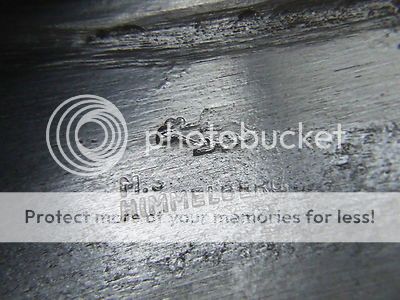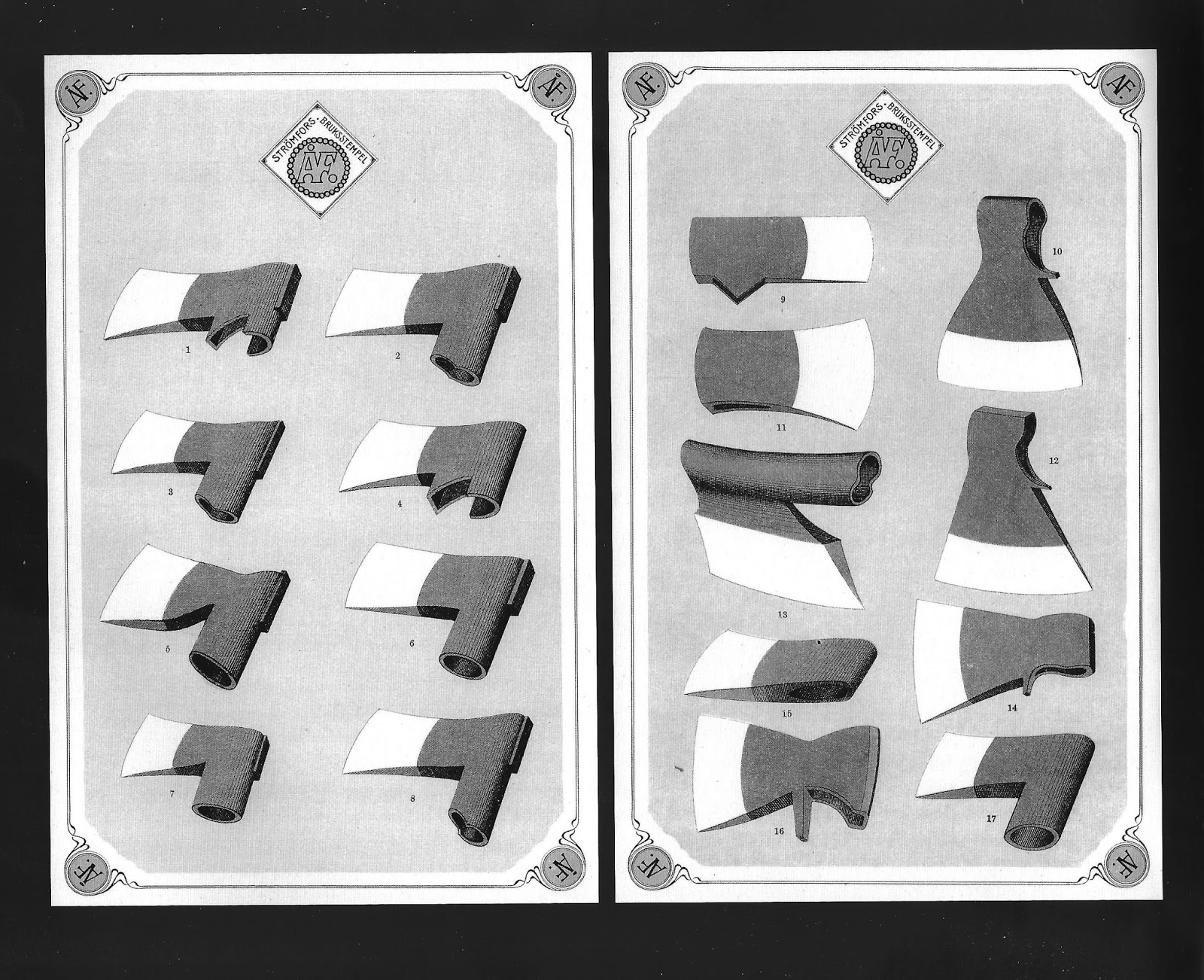Lookin forward to your thoughts on it.
So, for conversations sake, I dont know anything for sure, so please add/correct/redirect if you can.
A couple that did catch my eye for discussion were these:

Stubai = Wilhelm Lauer man Hinterhermsdorf They still produce axes and hatchets and seem like they are decent tools from reviews. These would be older used ones I would assume.
Stubai history (Austria):
http://stubai.com/index.php/en/history-stubai
14th cent.:
There were already forging cites existing in Fulpmes, which produced tools for the blooming iron mining city. The oldest documented forge had the inscription: Built in 1413 by miners.
1420:
Around 1420, Duchess Anna gave Master Stephan, the blacksmith from Stubai, a seal that represented a hatchet and a hammer crossed in a plate, to indicate the master´s products.
17th cent.:
Stubai´s iron industry produced agricultural Appliances and knives by 45 blacksmiths. Sales went far beyond the countries borders (by backpack carriers).
1680:
Transportation of goods moved from carrying to wheeling on carter wagons. This created so-called Stubai trading companies.
1742:
Founding of the trading house Volderauer. 70 years later - takeover by Pfurtscheller family (owners until 1902).
1897:
Founding of the cooperative. On the advice of the Chamber of Commerce, at the same time, the technical school for iron and steel processing was founded.
1945:
On the 1st of December 1945, the first Annual General Meeting in Freedom was held.
1950:
Expansion of merchandise export.
1960:
Modification of name to Stubai tool industry reg.Gen.m.b.H.
1964:
Agreement and regulatory Approval for the identification of all products with the advertising tag Stubai.
1996:
Construction of the most modern heat treatment factory for hardening in western Austria.
1997:
100th founding anniversary
1999:
Acquisition of Franz Krössbacher KG and establishment of the Centre of Excellence forging - hardening processing.
2003:
Modernization of the office in the Dr.Kofler-str. 1
2005:
Relocation of the Stubai outletshop from Kranerhaus to Headquarters at the
Dr. Kofler-str 1
2007:
Change of company title to Stubai KSHB GmbH Competence Center Forging - hardening - processing that processes several thousand tons of steel, forges raw products for its members and does on-demand forging and supplies parts for the automotive, mechanical engineering and mining industry.
2010:
Reconstruction of the head office in the Dr. Kofler road in a modern, representative building - start in Nov. 2010.
2011:
opening ceremony in October 2011
2012:
Name change into Stubai ZMV GmbH - Agency for Marketing and Sales 01.10.2012 retroactive to January 2012. The Stubai ZMV GmbH has been given the 100% usage of the brand and the new central headquarters.
GARANTI(E) Unsure Seems that it was stamped on a lot of different stuff like Warranty/Warranted from German, French, Italian, Austrian.

K. Zellinger in Himmelberg

*Also marked M. Sussman/Himmelberg

Here is an auction from 2014 that mentions An Austrian broad axe with faint mark of M SUSSMAN c1910 with 13"" edge.
https://www.the-saleroom.com/fr-fr/...0006/lot-3123b8c3-1dbd-4d50-9eee-a42e011beae7

Himmelberg is a town in Austria. Austria borders Slovenia. Austria was annexed by Hitler in 1938. One of the major references to axe/tool manufacturers is the Mueller Hammerwerk that moved to Himmelberg in 1884. The other names stamped with Himmelberg could have been other small blacksmiths distinguishing themselves, export destination marks, maybe what they did before having a common mark. Marks could have been affected by Russian/German occupation?
This is taken from the Muller home site under Tradition.
The Müller forge was first mentioned documentarily in 1675. Our forebear Peter Müller works in the forge Am Paalbach. Where the River Paalbach flows into the frothy River Mur you will find a small sooty forge on the bushy banks. The little village is Steindorf in the district of Murau in Styria. The smith is Peter Müller. He is the toolsmith, living in a time of wars, epidemics, earthquakes and the plague. And the business runs well. Clients are the farmers of the surrounding environment and travelling salesmen. The smithy lies directly on the royal post and commercial road, which runs along the River Mur in the Mur valley. It is the connecting road over the Tauern mountains to Salzburg and further north to the German trading centres. This region is connected to the wide world
In the year 1785 Martin Müller processes the meanwhile world famous cast steel of Paal into high quality hand tools. In 1823 Georg Müller relocates his forge to Turrach, due to the much better conditions. The industrialization reaches Austria. The first advances in mechanization set in in the factories. Machines begin to repress the workers
But the invention of the steam engine leads the railway to its triumphal procession, which raises the demand for steel enormously. The Eisenwurzen region reaches its peak and Turrach becomes the central point of iron and steel production in middle Europe. Martin Müller and his son Georg are attracted and in 1823 they relocate the Müller forge to this area. An atmosphere of change dominates and a new forge is set up. The father hands the forge over to his son Georg. The business profits by the boom of the iron trade.
In the year 1884 Bartholomäus Müller finds his way to a niche in Himmelberg. The rise is followed by a fall. The steam engine makes the production independent of flowing water. New industrial centres develop in the east (Bohemia and Moravia) due to the stone coal deposits. It comes to a radical turnover in the whole iron industry of the region. War and a world economical crisis alternate. The region becomes a margin area and the tail lamp of the monarchy. Bartholomäus Müller (Georgs son) finds his way to a niche. He acquires a blacksmiths shop in the neighbouring town of Himmelberg. The river Tiebel doesnt freeze over in winter but flows out of the mountain at a water temperature of 6 °C. This geological uniqueness allows the business to produce in winter also. Therefore the production no longer underlies the fluctuations and can rise considerably.
In 1901 Leonhard Müller takes over the forge and distinguishes himself from the products of other smiths by registering his own trade mark. Leonhard is the grandfather of todays business owners Seppi, Wolfgang and Leonhard. He manages the company until his death in the year 1954. Remarkably, he added the trade mark (IHS) to his tools, to distinguish himself from other forge businesses. These tools were sold at markets in the region. Business trips were made by bicycle. This way customers were acquired in places as far away as Linz.
http://www.mueller-hammerwerk.at/en/tradition.html
Just guessing but I think they might be a mix of older used axes and newer ones that might be earlier renditions of existing makers and maybe long gone ones produced in the area as well as older German makers. Some may be imports to there as well. Imports to me and you here in the US are different that imports to Slovenia though.
So, many of the marks are obscured and it is hard to make them out but there are some that have weight marks placed kind of where Mueller would have for example.
This is the one I ordered that arrived last night:


It weight 1lb 11.5oz. It seems well made. I cant find anything on the makers markings but 1964, to me, gives a date range to a degree. It doesnt look like the others listed. It looks Russian to me but that is based solely off of other internet sources and previously posted materials. It could be Finnish, Austrian, or Russian without something on the stamp I cant say. It looks and smells like Russian Block surplus to me at least what I think of from SKS and Bulgarian/Yugo firearms (Cosmoline). It also looks like there was something lightly stamped on the reverse side that may have been worn off or removed. I will clean it up and with a wheel and see if there is anything on there.
Some resources (for your axe reading pleasure) that I was perusing while trying to figure this out:
http://www.bladeforums.com/forums/showthread.php/1348572-Russian-Axe-Toporsib
http://woodtrekker.blogspot.com/2015/09/the-taiga-axe-russian-perspective-on.html
It also could be Finnish made for all I know as Finland was occupied by Russia and Billnäs, Kellokoski-Mariefors and Strömfors could have shipped them east:
Image 4. The Forge at Strömfors also made axes but they were not able to compete with Billnäs or even Kellokoski-Mariefors. The models they made were identical with the other forges, exept for the model 2 which was only made by Strömfors and was modeled after the Viborg style axe.The models 15, 11 and 9 are considered "American" axes
http://northernwildernesskills.blogspot.com/2013/08/all-you-ever-wanted-to-know-about.html
Blog post about Russian axe/handling
http://www.trapperman.com/forum/ubbthreads.php/topics/5392950/Re:_Making_axe_handles
Bushcraftusa thread of one reminiscent of the shape:
http://bushcraftusa.com/forum/threads/new-to-me-russian-axe-pics-and-first-trial.84130/
From earlier in post:
Here is a video that was posted here previously (if you havent seen it, its pretty cool):
http://www.bladeforums.com/forums/showthread.php/919485-Happy-People-A-year-in-Taiga
Happy People: A Year in the Taiga
https://www.youtube.com/watch?v=fbhPIK-oBvA
Smaller Taiga axe from video:

Larger version from video:

Some actual German axes in there? I would think so.
Some rare ones? defined by maker or availability now a days possibly.
Finnish made axes during Russian occupation sent around ?.
Austrian axes in there Definitely.
Original Russian ?
On a side note there are frequently heads being sold as unmarked Hudson Bay patterns that look an awful lot like some of the unmarked hatchets that that offered from the same vendor.
Great, now I want a traditional Finnish axe to mess around with...











